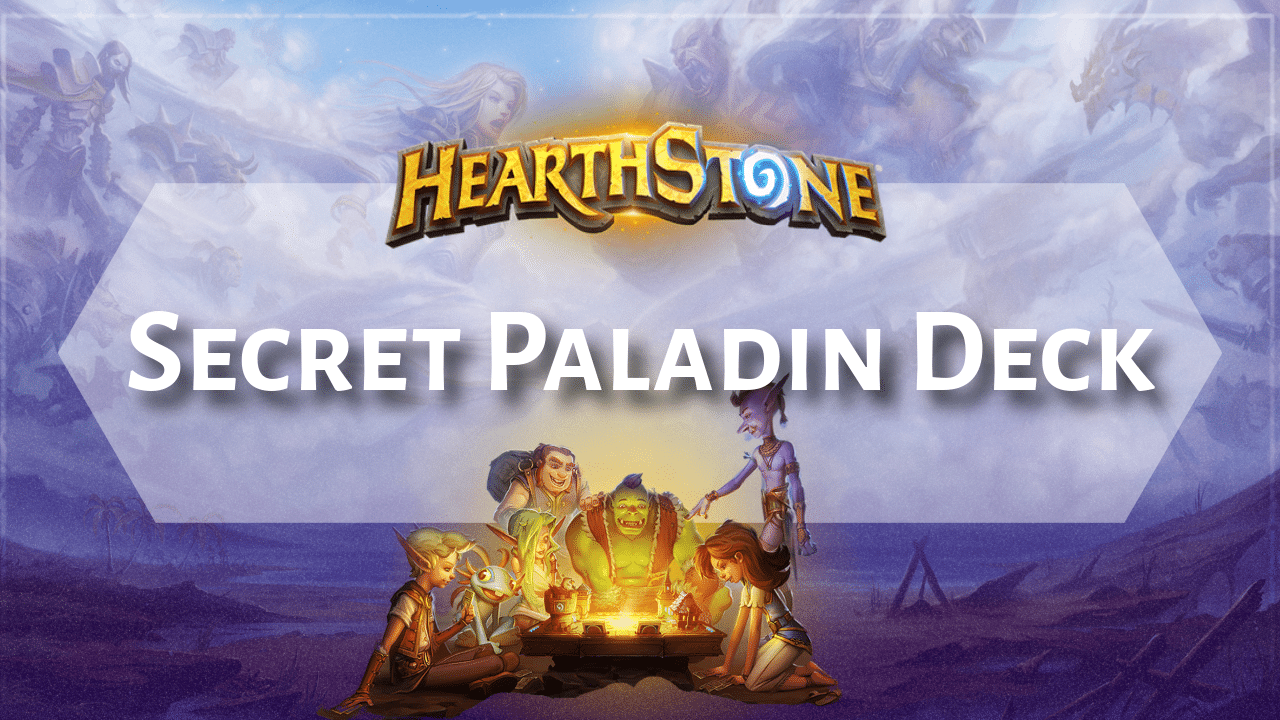
Hearthstone Secret Paladin Deck: Introduction to Secret Paladin
Secret Paladin is a midrange Paladin deck built around the strategic use of Secrets to disrupt the opponent’s plays and maintain board control. The deck’s core strength lies in playing multiple Secrets simultaneously, forcing the opponent to navigate an unpredictable battlefield while protecting key minions. By leveraging the synergy between Secrets and minions that benefit from them, Secret Paladin can establish an early board presence and apply consistent pressure. Some versions of the deck lean heavily into aggression, focusing on fast starts and tempo-driven strategies to close out games quickly.
Originally introduced in The Grand Tournament expansion, Secret Paladin gained notoriety with Mysterious Challenger, a powerful card that pulled multiple Secrets from the deck in a single turn, creating massive tempo swings. Combining this with cards like Avenge and Muster for Battle, the deck became a dominant force. Over time, Secret Paladin evolved, particularly after the Year of the Mammoth rotation, which shifted the archetype primarily to the Wild format. Rise of Shadows later reintroduced Secret-based support, leading to a resurgence of the deck in various forms. Over the years, Secret Paladin has adapted to include aggressive builds focused on tempo, midrange versions with sustained threats, and even hybrid versions integrating Mech synergy to strengthen the early game.
Secret Paladin has found success in both Standard and Wild formats at different points in Hearthstone’s history. In Wild, the deck benefits from powerful tools like Call to Arms, which recruits three 2-cost minions to maintain board presence efficiently. Cards like Order in the Court help reshuffle the deck to ensure consistent draws, while defensive strategies incorporating large Taunt minions can overwhelm opponents. Wild versions of the deck have continued to evolve, utilizing key synergies to create overwhelming board states. Whether played aggressively or with a midrange approach, Secret Paladin remains a formidable archetype with a long-standing legacy in Hearthstone.
Key Cards and Synergies
Secret Paladin revolves around a carefully curated package of Paladin Secrets that create an unpredictable and disruptive board state. Common choices include Avenge, Noble Sacrifice, Oh My Yogg!, Galloping Savior, Never Surrender!, and Repentance, with selections often adjusted based on the meta. Secrets are most effective when deployed through synergy cards rather than played directly, maximizing tempo and efficiency.
The deck’s backbone is its synergy minions, led by Mysterious Challenger, a pivotal card that pulls multiple Secrets from the deck onto the board, generating a powerful turn 6 tempo swing. Secretkeeper thrives in early-game scenarios, growing stronger with each Secret played, making it a high-priority keep in the mulligan. Sword of the Fallen provides both card draw and free Secret deployment, making it one of the most valuable early-game tools in aggressive builds. Northwatch Commander and Sunreaver Spy ensure Secret consistency by drawing or benefiting from having Secrets in play. Other notable minions include Crossroads Gossiper, which gains stats based on active Secrets, and Commander Rhyssa, which enhances Secret effects.
Beyond Secret synergy, several support cards reinforce the deck’s aggressive or midrange playstyle. First Day of School offers free early-game board presence, while Crabrider provides immediate pressure with Windfury and Rush, particularly when buffed by Hand of A’dal. Knight of Anointment ensures key spells like Avenge, Conviction, or Hand of A’dal are drawn consistently. Conviction serves as a powerful game finisher, granting additional attack to multiple minions. Kazakus, Golem Shaper provides a flexible mid-game tool, with 5-mana Golems often being the strongest choice due to their impactful abilities.
For additional control and resilience, Ogremancer punishes spell-heavy opponents, Hammer of the Naaru offers both a weapon and a defensive Taunt minion, and Alexstrasza the Life-Binder can serve as a finisher, removal, or healing tool. Other key minions include Goody Two-Shields, which excels in early trades with Divine Shield, and Argent Protector, which provides valuable minion protection.
In Wild format, the deck gains access to powerful tools like Call to Arms, which summons three 2-cost minions for immediate tempo, and Dun Baldar Bridge, enhancing those summons with Taunt. Order in the Court ensures timely draws for critical cards like Mysterious Challenger, though it can affect overall deck consistency. Other Wild options like Keeper’s Strength provide board-wide buffs, while Blood Matriarch Liadrin offers Divine Shield and Rush for smaller minions, enabling strong trades. With these tools, Secret Paladin remains a formidable and flexible archetype, capable of overwhelming opponents with a well-timed sequence of Secrets and synergistic minions.
Mulligan Strategy
Establishing early board control is the top priority for Secret Paladin, as maintaining tempo allows the deck to snowball its advantage. A strong mulligan is crucial, with a focus on finding key early-game cards that enable board presence and tempo. Secrets are generally not kept in the opening hand unless there is direct synergy, such as with Secretkeeper in Wild. Instead, the goal is to draw and play Secrets through cards like Sword of the Fallen to maximize efficiency and avoid clogging the hand.
The highest-priority keeps include First Day of School, which provides immediate board presence and allows for a more aggressive mulligan strategy. Sword of the Fallen is a must-keep in every matchup, as it pulls Secrets directly from the deck while offering additional board control. Crabrider is another strong early-game option, capable of applying immediate pressure, especially when buffed. If neither Sword of the Fallen nor First Day of School is available, Knight of Anointment is a reasonable keep to cycle into a useful spell while developing a body on board.
Certain cards are kept conditionally based on the rest of the hand. Hand of A’dal is worth keeping if Crabrider is already in hand, particularly when going second with The Coin, to create a strong early-game threat. Northwatch Commander is sometimes kept alongside Sword of the Fallen to ensure a steady flow of Secrets.
In Wild, Secretkeeper is a good keep when paired with at least one Secret to capitalize on its early scaling.
Order in the Court can also be a viable keep in Wild if the goal is to set up a strong midgame by ensuring the timely draw of Mysterious Challenger. By optimizing the mulligan and prioritizing key early-game cards, Secret Paladin can quickly establish board dominance and pressure opponents from the start.
Gameplay and Tips
In the early game (turns 1-3), establishing board presence is the primary focus. Cards like First Day of School, Intrepid Initiate, Righteous Protector, and Knight of Anointment provide early tempo and ensure a solid start. Sword of the Fallen should be played as soon as possible, ideally on turn 2, to begin thinning the deck and deploying Secrets automatically. Attacking with it early maximizes its value and sets up future turns efficiently.
During the mid-game (turns 4-6), maintaining pressure with strong minions and tempo plays is crucial. Crabrider can be highly effective, especially when buffed by Hand of A’dal to trade efficiently or deal significant damage. Mysterious Challenger is the defining turn 6 power spike (or turn 5 with The Coin), pulling multiple Secrets onto the board and creating a difficult scenario for the opponent. Awareness of potential counterplay, such as an opponent’s Secrets or board clears, can help maximize its impact. Additional mid-game threats like Kazakus, Ogremancer, and Hammer of the Naaru provide flexibility—Kazakus offers customizable Golems, often favoring the 5-cost Divine Shield duplication option for maximum board presence.
Secret Paladin often aims to close out games before reaching the late game (turns 7+). Aggressive versions rely on finishers like Conviction, which provides significant burst damage, particularly when played after turn 5 to buff multiple minions. Alexstrasza the Life-Binder can serve as a finisher by reducing the opponent’s health or as a defensive tool when necessary. In Wild, the late-game approach may involve generating overwhelming board states through Dun Baldar Bridge and Call to Arms, creating waves of threats that opponents struggle to remove.
General gameplay principles include maintaining board control, trading efficiently in the early game, and leveraging Secrets to disrupt opponents’ plans. Anticipating board clears like Consecration or Hysteria is key to sustaining pressure while minimizing risk. Playing cards in the correct sequence is crucial, particularly before using Conviction, to ensure buffs land on optimal minions. Cards like Goody Two-Shields should be played as the last action of the turn to prevent accidental Spellburst activation. Awareness of active Secrets and how they interact with an opponent’s potential plays is essential for maximizing their impact and securing victory.
Variations and Tech Choices
Secret Paladin offers multiple viable archetypes, each catering to different playstyles and strategic approaches. Aggressive Secret Paladin prioritizes a low mana curve, aiming to dominate the board early by utilizing Sword of the Fallen to deploy Secrets directly from the deck. This strategy maximizes tempo, ensuring that the opponent is constantly reacting rather than executing their own game plan. With a strong early presence, the deck applies relentless pressure, setting up lethal damage through buffs like Conviction to close out games quickly. Efficient minions, such as Crabrider and Secretkeeper, further accelerate the deck’s aggressive nature, forcing the opponent into a defensive position before they can stabilize.
On the other hand, Midrange Secret Paladin adopts a more balanced approach, leveraging a combination of early board presence and sustained mid-game threats. While still making use of Sword of the Fallen and Secrets to control the board, this variant includes more substantial minions like Kazakus and Hammer of the Naaru, ensuring the deck can transition into a longer game if needed.
By maintaining board control and applying consistent pressure, Midrange Secret Paladin is better equipped to handle decks that thrive in the late game, while still having the ability to push for a swift victory when the opportunity arises. This flexibility allows the deck to remain competitive against a wider range of opponents, making it a strong and adaptable choice in various metas.
In Wild, Secret Paladin has additional variations. Mech Hybrid Secret Paladin blends the Secret package with Mech synergy, creating a stronger early game and maintaining board presence with resilient Mechs. Wild Secret Paladin can take advantage of powerful format-exclusive cards like Call to Arms and Dun Baldar Bridge for explosive board development. Some versions incorporate Order in the Court to improve consistency in drawing key cards like Mysterious Challenger, while others focus on overwhelming opponents with large Taunt minions, potentially enhanced by Keeper’s Strength. Cards like Blood Matriarch Liadrin can also provide strong early tempo advantages.
To adapt to the evolving meta, incorporating the right tech choices is crucial for optimizing the performance of a Secret Paladin deck. Cards like Ogremancer can be highly effective against spell-heavy opponents, punishing decks that rely on cheap spells by summoning additional minions and making it harder for them to maintain control.
Other tech options, such as minions that counter Secrets, weapon removal, or anti-aggro tools, can be included depending on the most common strategies in the current meta. Adjusting the deck to counter prevalent threats ensures that Secret Paladin remains a strong and versatile archetype, capable of performing well in both Standard and Wild formats. By selecting the appropriate variant—whether aggressive, midrange, or hybrid—and fine-tuning card choices accordingly, players can maximize their chances of success across different matchups.
Counters and Weaknesses
Defeating Secret Paladin requires understanding their Secrets and playing around them efficiently. Recognizing common Secret choices, such as Avenge, Noble Sacrifice, Oh My Yogg!, and Galloping Savior, allows you to minimize their impact by triggering them in a controlled manner. Proper sequencing when attacking or playing spells can prevent key Secrets from disrupting your game plan.
Establishing early board presence before Mysterious Challenger is played can give you minions to test and dismantle the web of Secrets without losing tempo. However, be cautious of board clears like Consecration, which can wipe out small minions before the Challenger turn. If the Paladin secures a strong board state, removal spells—both single-target and AoE—become crucial. Spells like Hysteria or Twisting Nether can effectively reset the board after Mysterious Challenger deploys multiple Secrets, preventing the Paladin from snowballing their advantage.
Tech cards that directly counter Secrets, such as minions or spells that destroy or bypass them, can also be highly effective. Disrupting the Paladin’s game plan by negating their Secret synergies forces them into a weaker position, making it easier to take control of the match. By carefully managing your plays and countering their key turns, you can significantly reduce the effectiveness of Secret Paladin and secure victory.













